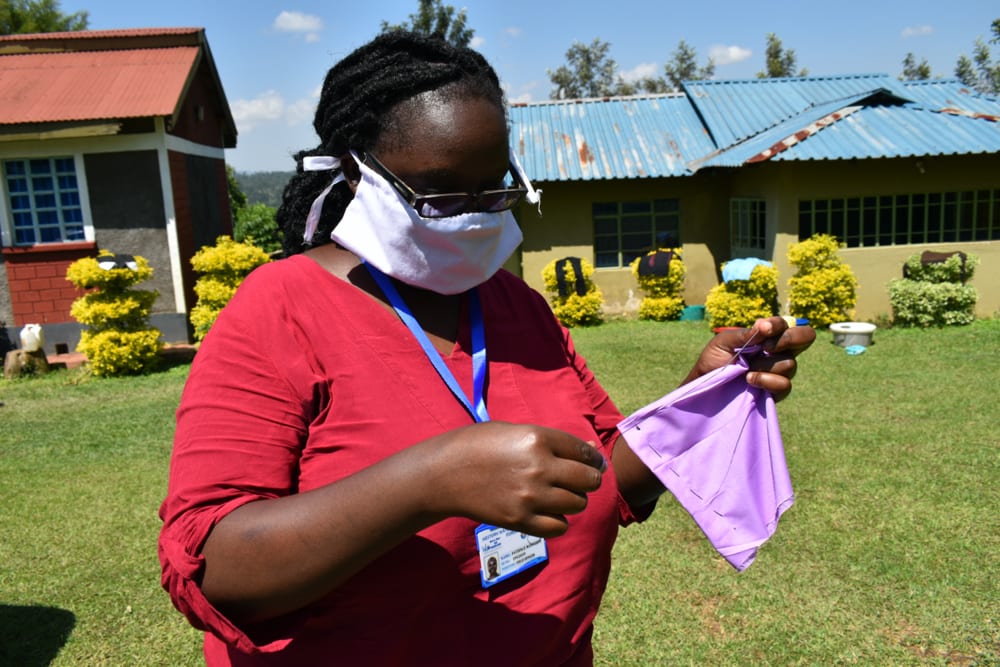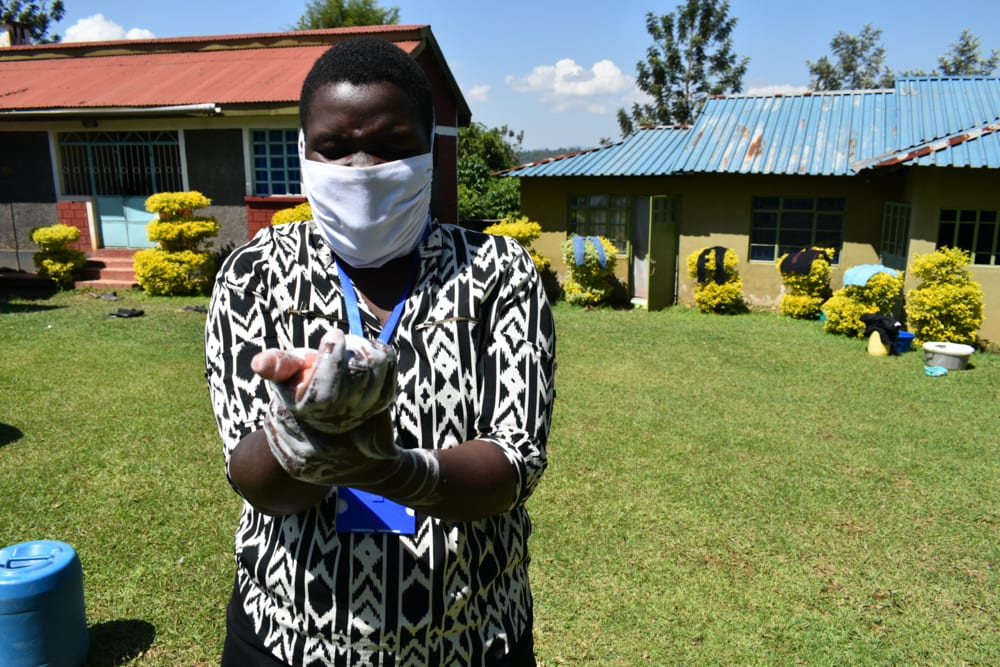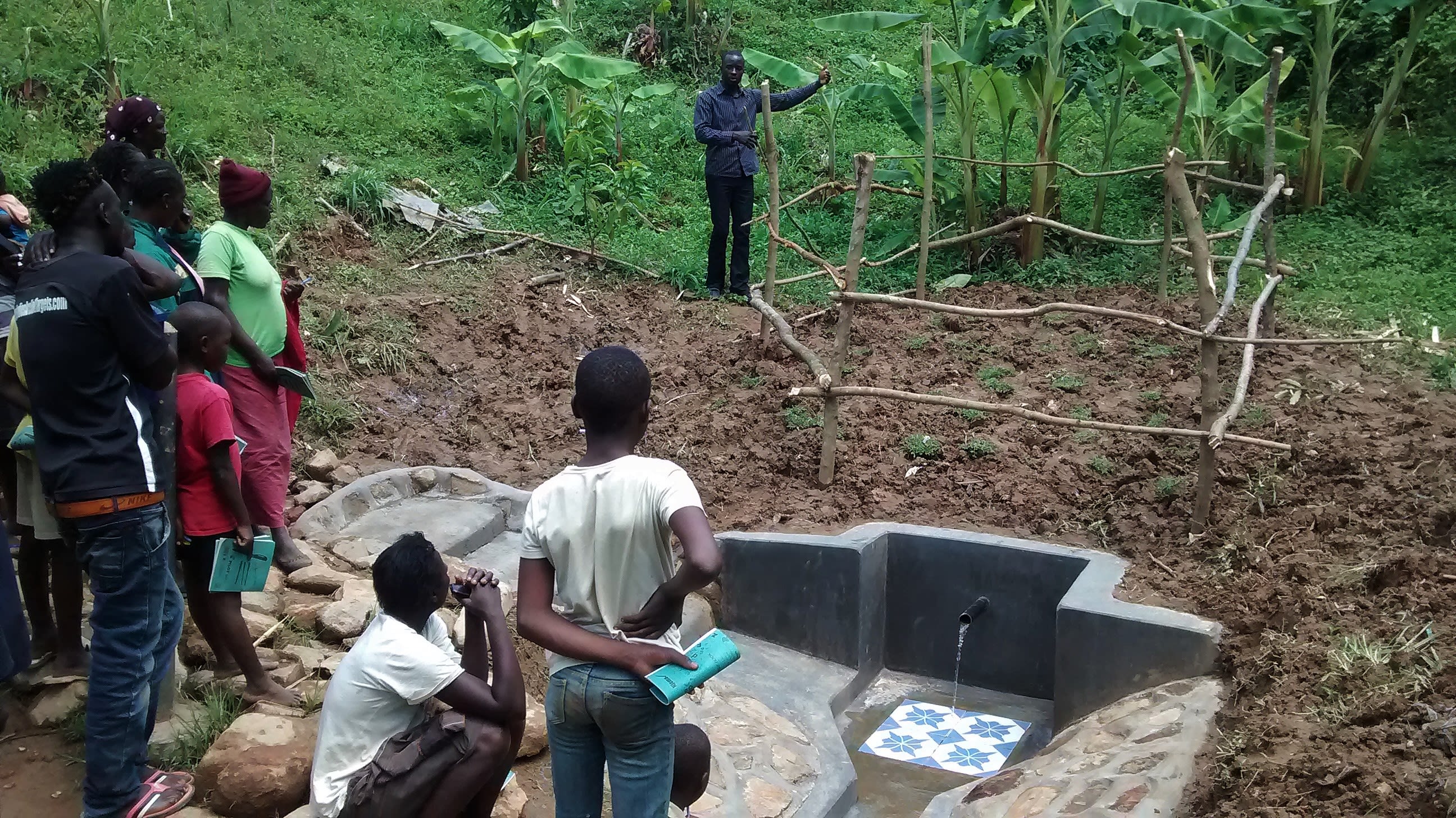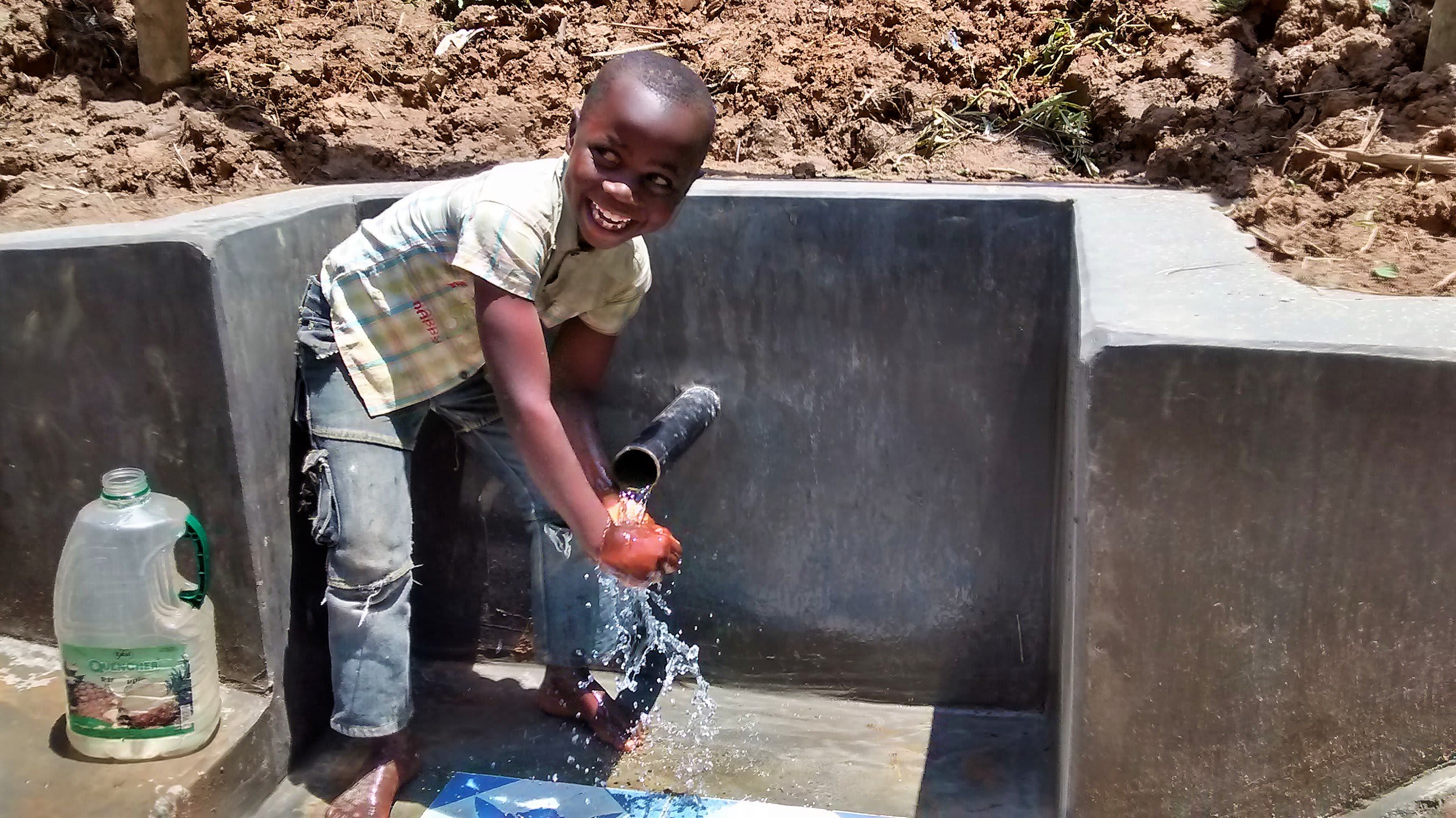July, 2020: COVID-19 Prevention Training Update at Ivulugulu Community, Ishangwela Spring
Our teams are working on the frontlines of the COVID-19 pandemic. Join us in our fight against the virus while maintaining access to clean, reliable water.

Reviewing prevention reminders chart
We are carrying out awareness and prevention trainings on the virus in every community we serve. Very often, our teams are the first (and only) to bring news and information of the virus to rural communities like Ivulugulu, Kenya.

Handwashing
We trained more than 13 people on the symptoms, transmission routes, and prevention of COVID-19. Due to public gathering concerns, we worked with trusted community leaders to gather a select group of community members who would then relay the information learned to the rest of their family and friends.

Practicing handwashing steps
We covered essential hygiene lessons:
- Demonstrations on how to build a simple handwashing station
- Proper handwashing technique
- The importance of using soap and clean water for handwashing
- Cleaning and disinfecting commonly touched surfaces including at the water point.

Handwashing
We covered COVID-19-specific guidance in line with national and international standards:
- Information on the symptoms and transmission routes of COVID-19
- What social distancing is and how to practice it
- How to cough into an elbow
- Alternative ways to greet people without handshakes, fist bumps, etc.
- How to make and properly wear a facemask.

Homemade mask tutorial
During training, we installed a new handwashing station with soap near the community’s water point, along with a sign with reminders of what we covered.

A young girl receives the sample mask made at training
Due to the rampant spread of misinformation about COVID-19, we also dedicated time to a question and answer session to help debunk rumors about the disease and provide extra information where needed.

Trying on her mask made at training
We continue to stay in touch with this community as the pandemic progresses. We want to ensure their water point remains functional and their community stays informed about the virus.

Building a new tippy tap handwashing station
Water access, sanitation, and hygiene are at the crux of disease prevention. You can directly support our work on the frontlines of COVID-19 prevention in all of the communities we serve while maintaining their access to safe, clean, and reliable water.

May, 2018: Ivulugulu Community Project Complete
Ivulugulu Community now has clean water! Ishangwela Spring has been transformed into a flowing source of clean water thanks to your donation. The spring is protected from contamination, five sanitation platforms have been provided for the community, and training has been done on sanitation and hygiene.
New Knowledge
We started telling people about the importance of good hygiene and sanitation as soon as we set foot in Ivulugulu. The village elder and Mrs. Sheba Atuta went around their community inviting everyone to attend these sessions. We were happy to find 20 community members who opted to sacrifice valuable time on their farms for information that can benefit them in the long run.
Mrs. Sheba Atuta offered up her spacious yard for training. Most participants sat on wooden chairs, while others found a comfortable sitting place on rocks or soft grass. A moderate amount of sunshine provided vitamin D that was enjoyed as the training went on.

There was a lady who had just gotten married and moved to this village from Central Kenya, and she did not understand the native language. She only knew her mother tongue, which no other person but her husband could understand. There were also two old women in the group could not understand Kiswahili.
After a lengthy discussion, it was agreed that the training should be carried out in the native language, Luhya. The new bride still wanted to attend training and just observe the practical sessions. Then, later on, she would learn every detail from her husband who was one of the other participants.
We covered several topics including leadership and governance; operation and maintenance of the spring; healthcare; family planning; immunizations; the spread of disease and prevention. We also covered water treatment methods like solar disinfection, personal care like handwashing, environmental hygiene, hygiene promotion, and many other things. Since we were near the spring, we could run through hands-on management and maintenance demonstrations.

Learning about how to keep clean water flowing!
They most enjoyed the demonstrations for brushing teeth and were surprised at how many little things they had been doing wrong. Since they had already been helping the artisan around the spring, they were particularly interested in learning about all the routine chores they should do to care for their new clean water source. It was obvious they've already taken great responsibility for the success of this project.
Mr. Patrick Lumumba is a retired teacher who found training particularly enlightening.
"I count myself blessed," he said during the training.
"Even though I'm a learned person, I was never taught what we have learned here today in school or college. This kind of information is very rare, and I wish I got it earlier. It has come when most of my teeth have been extracted and I've suffered a lot of health challenges due to ignorance," he continued.
"However, I will start practicing all that we have been taught here and my household will learn the same from me. Do the same for yourself and your household so that we be healthy people!"
The training has already brought about positive changes in the village. People have already dug a drainage system above their water source to prevent contamination when it floods. Many homes now have dish racks, clotheslines, and have improvised handwashing facilities. Their compounds are very tidy.
Sanitation Platforms
All five sanitation platforms have been installed. These five families are happy about this milestone of having a private latrine of their own and are optimistic that people will no longer leave waste outdoors. We are continuing to encourage families to finish building walls and roofs over their new latrine floors.

Thumbs up for a safe latrine floor that's easy to clean!
Spring Protection
Community members provided all locally available construction materials, e.g bricks, wheelbarrows of clean sand, wheelbarrows of ballast, fencing poles and gravel. Accommodations and meals were provided for the artisan, too. Men and women lent their strength to the artisan to help him with manual labor. The spring area was excavated to create space for setting the foundation of polyethylene, wire mesh and concrete. After the base had been set, both wing walls and the headwall were set in place using brickwork. The discharge pipe was fixed low in place through the headwall to direct the water from the reservoir to the drawing area.

Excavation to make way for a stable foundation.
As the wing walls and headwall were curing, the stairs were set and ceramic tiles were fixed directly below the discharge pipe. This protects the concrete from the erosive force of the falling water and beautifies the spring. The process of plastering the headwall and wing walls on both sides reinforces the brickwork and prevents water from the reservoir from seeping through the walls and allows pressure to build in the collection box to push water up through the discharge pipe.

The source area was filled up with clean hardcore and covered with a polyethylene membrane to eliminate any potential sources of contamination.

Different layers protect the flowing water from contamination.
Since this is normally a very muddy area, people would often slip, fall, and suffer injuries when going back and forth to fetch water. The artisan advised community members to help him do some extra work for this spring protection project - to collect a lot of extra stones to be arranged around the spring. This has kept the surrounding area much drier and tidier, free from mosquitoes and mud.
Everyone in the village, even those from the neighboring villages, can now easily get clean water from Ishangwela Spring!

Mr. Geoffrey Amara was one of the first people there.
"I no longer have to carry a tin around to use for drawing water because fetching water is now very easy. I just place my container under the discharge pipe then the water falls in until it's full! Getting to the drawing area has also been made easy and comfortable by the staircases and stones arranged in the route leading to, and the area surrounding our spring," he said.


 Protected Spring
Protected Spring
 Rehabilitation Project
Rehabilitation Project









































